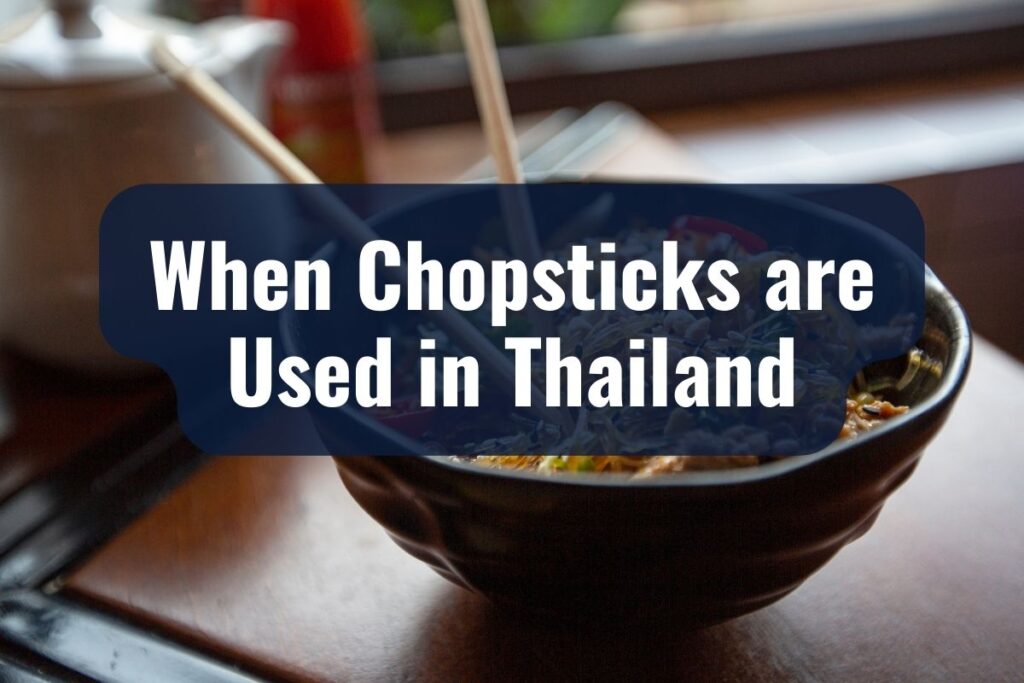Thailand is renowned for its rich cultural tapestry and exquisite culinary offerings. As foreigners navigate this fascinating landscape, understanding the local dining etiquettes becomes an essential part of the immersive experience. This article aims to answer one specific question about Thai dining culture: “Do they use chopsticks in Thailand?“
While exploring Thailand, one quickly discovers the sheer variety of eating habits and utensils, reflective of the country’s multifaceted cultural influences. From bustling street food stalls in Bangkok to elegant restaurants in Chiang Mai, each setting offers a unique dining experience. Understanding when and how chopsticks are used in this diverse culinary landscape not only enhances your dining experience but also deepens your appreciation of Thai culture.
KEY TAKEAWAYS
- Chopsticks in Thailand are used selectively, mainly for noodle dishes and Chinese-influenced cuisine.
- The primary dining utensils in Thailand are the spoon and fork, not chopsticks.
- Chopstick usage in Thailand reflects its cultural blend, especially Chinese influence.
- Proper chopstick etiquette in Thailand includes avoiding pointing and vertical placement in bowls.
- Practical tips for foreigners include basic Thai phrases and observing local dining habits.
- Embracing Thai dining culture involves respect for local customs and trying various dishes.
Do They Use Chopsticks in Thailand? The Role of Chopsticks in Thai Cuisine
Thai cuisine, with its rich flavors and diverse influences, offers a unique dining experience that often raises questions about traditional eating utensils, particularly the use of chopsticks.
Historical Perspective: Origin and Influence
Chopsticks are not indigenous to Thai culture. Their presence in Thai dining is a testament to the cultural and trade exchanges with neighboring countries, particularly China. Over centuries, these interactions have subtly woven chopsticks into certain aspects of Thai culinary traditions. However, unlike in China, Japan, or Korea, where chopsticks are the primary utensils, in Thailand, their usage is more selective and dish-specific.
Comparison with Neighboring Countries’ Dining Practices
In contrast to the widespread use of chopsticks in many East Asian countries, Thailand’s culinary customs have evolved differently. The Thai table typically features a fork and spoon as the main utensils. This distinction highlights the unique position of Thailand as a cultural crossroads in Southeast Asia, where various cultural elements blend harmoniously.
Understanding the role of chopsticks in Thai cuisine requires recognizing this broader context of cultural exchange and adaptation. While chopsticks are used in certain Thai dishes, their presence is a reflection of external influences rather than an indigenous tradition.
When Chopsticks are Used in Thailand

In the diverse culinary landscape of Thailand, chopsticks are reserved for specific dishes and dining settings, reflecting the nuanced interplay between traditional Thai customs and external cultural influences.
Thai Dishes Commonly Eaten with Chopsticks
| Context | Description |
| Noodle Dishes | Commonly eaten with chopsticks; includes Pad Thai, Boat Noodles, etc. |
| Street Foods | Chopsticks often used for quick eats like stir-fried noodles or soups. |
| Chinese-Thai Cuisine | Thai-Chinese fusion dishes traditionally eaten with chopsticks. |
| Regional Variations | More prevalent chopstick use in areas with strong Chinese influence. |
| High-End Dining | Upscale restaurants and hotels may offer chopsticks for international guests. |
Noodle Dishes: Chopsticks are most commonly used for noodle-based dishes. From the famous Pad Thai to the savory boat noodles, chopsticks offer practicality and ease in maneuvering these slippery strands. Dishes like Khao Soi, a northern Thai noodle curry, or the street-side favorite, Pad See Ew, are often enjoyed with chopsticks.
Certain Street Foods: In bustling street markets, chopsticks are frequently seen in the hands of locals and tourists alike, especially when savoring quick eats like stir-fried noodles or noodle soups.
Chinese-Influenced Cuisine: Due to historical Chinese influence, certain Thai-Chinese fusion dishes are traditionally eaten with chopsticks. Examples include dim sum and various stir-fried dishes that have been incorporated into Thai cuisine while retaining their Chinese roots.
Dining Settings Where Chopsticks are More Prevalent
Chinese-Thai Restaurants: In restaurants that specialize in Thai-Chinese cuisine, chopsticks are commonly provided alongside other utensils, honoring the culinary heritage of these dishes.
Regional Variations: In areas with a strong Chinese community presence, such as Bangkok’s Chinatown or parts of Chiang Mai, chopsticks are more commonly used, reflecting the local demographic and cultural influences.
High-End Dining and Hotels: Some upscale restaurants and hotels catering to a diverse clientele may offer chopsticks as an option, acknowledging the preferences of international guests.
Alternatives to Chopsticks in Thai Dining
While chopsticks have their place in certain aspects of Thai cuisine, the predominant eating utensils in Thailand are the spoon and fork. This practice not only sets Thailand apart from its chopstick-using neighbors but also reflects a unique aspect of Thai culinary culture.
The Use of Spoon and Fork: The Thai Way
Spoon as the Main Utensil
In traditional Thai dining, the spoon is the primary utensil. It is used for both scooping up food and eating directly from it. This practice is especially common in meals involving rice, which is a staple in Thai cuisine. The spoon effortlessly accommodates the texture and consistency of Thai dishes, from curries to fried rice.
Fork for Maneuvering Food
Contrary to Western dining practices, the fork in Thai dining is not typically used to bring food to the mouth. Instead, it acts as a helper utensil to push or cut food, aiding in transferring items onto the spoon.
Regional Variations in Utensil Use
Northern and Northeastern Thailand
In these regions, you might also encounter the use of hands for eating, particularly with sticky rice, a regional staple. Eating with hands is an age-old tradition, offering a direct and tactile connection with food.
Influence of Royal Customs
The current utensil practice in Thailand was influenced by King Chulalongkorn’s (Rama V) adoption of Western dining implements in the late 19th century. This royal influence gradually permeated Thai society, resulting in the unique combination of spoon and fork that is widely used today.
Adaptations in Contemporary Settings
Adapting to Global Dining Practices
In cosmopolitan areas and tourist destinations, it’s not uncommon to find Western utensils like knives and forks in use, catering to international preferences.
Flexibility in Modern Thai Dining
Contemporary Thai restaurants, both in Thailand and abroad, often offer a range of utensils to accommodate the diverse dining habits of their customers, showcasing Thailand’s adaptability and openness to global influences.
Cultural Nuances and Etiquette

Understanding the cultural nuances and etiquette of using chopsticks in Thailand is crucial for foreigners. It not only reflects respect for Thai customs but also enhances the dining experience.
Proper Way to Use Chopsticks in Thailand
- Holding Technique: Similar to other Asian cultures, the proper way to hold chopsticks is between the thumb, index, and middle fingers. It’s important to grasp them comfortably yet firmly enough to pick up food without difficulty.
- Eating Etiquette: When using chopsticks, it’s customary to bring the bowl or plate close to your mouth to avoid dropping food. This practice is considered polite and is a common sight in Thai dining.
Cultural Taboos and Etiquette Associated with Chopstick Use
- Avoiding Certain Gestures: Pointing with chopsticks at others or objects is considered impolite. Similarly, sticking chopsticks vertically into a bowl of rice is a taboo as it resembles incense sticks used in funeral rites, which can be seen as an omen of bad luck.
- Passing Food: Directly passing food from one set of chopsticks to another is another cultural faux pas, as this gesture is reminiscent of funeral practices in some Asian cultures.
Insight into Thai Dining Manners and Table Etiquette
- Sharing Dishes: Thai meals are often communal, with shared dishes. Using the serving spoons provided for each dish is a sign of good manners, ensuring hygiene and respect for fellow diners.
- Observing Others: When in doubt, a good practice is to observe how locals use their chopsticks and follow suit. This approach shows a willingness to learn and adapt to local customs.
Practical Tips for Foreigners
For foreigners in Thailand, mastering the use of chopsticks and understanding dining etiquette can significantly enhance the cultural experience. Here are some practical tips to navigate chopstick use in Thailand with ease and confidence.
How to Politely Request or Decline Chopsticks
- Requesting Chopsticks: In restaurants where chopsticks are not automatically provided, you can politely request them by saying, “Khor chopsticks noi, khrap/kha” (for males/females), which means “Can I have chopsticks, please?”
- Declining Chopsticks: If you prefer not to use chopsticks, simply using the spoon and fork provided is acceptable. There’s no need for a formal decline unless chopsticks are specifically offered to you.
Learning Basic Thai Phrases Related to Dining
- Expressing Gratitude: Saying “Khob khun khrap/kha” (Thank you) after receiving any service or utensils shows politeness and appreciation.
- Asking for Help: “Chuay duay khrap/kha” means “Please help” and can be used if you need assistance, perhaps with a particular dish or utensil.
Observations and Tips from Expats and Locals on Chopstick Usage
- Observe and Learn: Watching how locals use chopsticks can be very instructive. Don’t hesitate to mimic their grip or technique.
- Cultural Openness: Remember that Thai people are generally understanding and accommodating when it comes to cultural differences in dining practices. Don’t worry too much about making mistakes; showing an effort to follow local customs is always appreciated.
- Practice Makes Perfect: If you’re not adept at using chopsticks, practicing with them during less formal settings, like street food dining, can be a good way to improve your skill in a low-pressure environment.
Embracing Thai Dining Culture

For foreigners residing in or visiting Thailand, embracing the local dining culture is an integral part of the experience. It goes beyond mere adaptation to utensils; it’s about appreciating and respecting the rich traditions and customs that define Thai culinary practices.
Encouragement to Try Different Utensils and Dishes
- Exploring with Openness: Be open to trying both chopstick and spoon-and-fork dining methods. Each offers a unique way to interact with different Thai dishes. Experimenting with various utensils can enhance your understanding and enjoyment of Thai cuisine.
- Sampling a Variety of Dishes: Thai cuisine is incredibly diverse. From street-side vendors to high-end restaurants, each offers a distinct taste of Thailand’s culinary richness. Embrace the opportunity to try a wide range of dishes, whether they require chopsticks, a spoon and fork, or even your hands.
The Importance of Respecting and Understanding Local Customs
- Respect as a Key to Cultural Immersion: Showing respect for Thai dining etiquette and practices is essential. It reflects an appreciation for the culture and facilitates deeper connections with locals.
- Learning from the Local Lifestyle: Immersing yourself in Thai dining culture can offer insights into the Thai way of life, values, and traditions. Food is a significant aspect of cultural identity, and understanding its nuances can lead to a more profound appreciation of Thailand.
Personal Growth and Cultural Adaptability
- Adapting to New Customs: Adjusting to different dining practices can be a rewarding challenge, contributing to personal growth and cultural adaptability.
- Building Bridges through Food: Sharing meals and understanding dining customs can be a powerful way to connect with Thai people, fostering mutual respect and friendship.
Related: How to be Polite in Thailand: A Practical Guide for Foreigners


